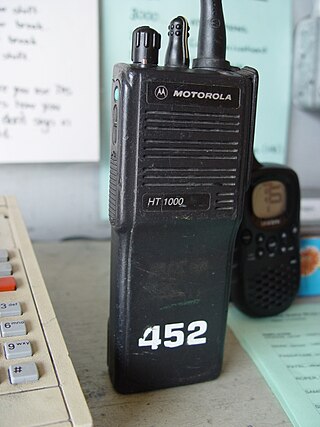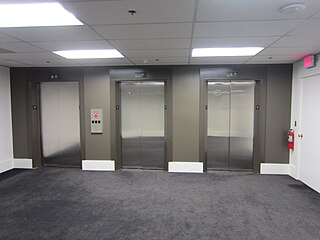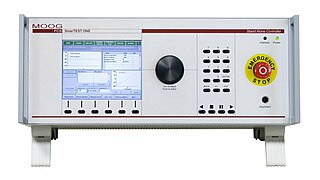
Dual-tone multi-frequency signaling (DTMF) is a telecommunication signaling system using the voice-frequency band over telephone lines between telephone equipment and other communications devices and switching centers. DTMF was first developed in the Bell System in the United States, and became known under the trademark Touch-Tone for use in push-button telephones supplied to telephone customers, starting in 1963. DTMF is standardized as ITU-T Recommendation Q.23. It is also known in the UK as MF4.

X10 is a protocol for communication among electronic devices used for home automation (domotics). It primarily uses power line wiring for signaling and control, where the signals involve brief radio frequency bursts representing digital information. A wireless radio-based protocol transport is also defined.

A game controller, gaming controller, or simply controller, is an input device or input/output device used with video games or entertainment systems to provide input to a video game. Input devices that have been classified as game controllers include keyboards, mice, gamepads, and joysticks, as well as special purpose devices, such as steering wheels for driving games and light guns for shooting games. Controllers designs have evolved to include directional pads, multiple buttons, analog sticks, joysticks, motion detection, touch screens and a plethora of other features.
compress is a Unix shell compression program based on the LZW compression algorithm. Compared to gzip's fastest setting, compress is slightly slower at compression, slightly faster at decompression, and has a significantly lower compression ratio. 1.8 MiB of memory is used to compress the Hutter Prize data, slightly more than gzip's slowest setting.

A dead man's switch is a switch that is designed to be activated or deactivated if the human operator becomes incapacitated, such as through death, loss of consciousness, or being bodily removed from control. Originally applied to switches on a vehicle or machine, it has since come to be used to describe other intangible uses, as in computer software.

Professional mobile radio are person-to-person two-way radio voice communications systems which use portable, mobile, base station, and dispatch console radios. PMR systems are based on such standards as MPT-1327, TETRA, APCO 25, and DMR which are designed for dedicated use by specific organizations, or standards such as NXDN intended for general commercial use. These systems are used by police, fire, ambulance, and emergency services, and by commercial firms such as taxis and delivery services. Most systems are half-duplex, in which multiple radios share a common radio channel, and only one can transmit at a time. Transceivers are normally in receive mode, the user presses a push-to-talk button on his microphone when he wants to talk, which turns on his transmitter and turns off his receiver. They use channels in the VHF and UHF bands, giving them a limited range, usually 3 to 20 miles depending on terrain. Output power is typically limited to 4 watts. Repeaters installed on tall buildings, hills or mountain peaks are used to increase the range of systems.

Kid Spark Education is a nonprofit organization that develops and produces affordable Mobile STEM Labs and curriculum for Schools and Youth Service Organizations. The Rokenbok Toy Company was founded in 1995 by Paul Eichen in the United States to create an heirloom quality toy system. The first Rokenbok toys debuted at the 1997 American International Toy Fair in New York City. In 2010 the company made a substantial push researching the effect of media, like Rokenbok, on developing minds. In 2015 the company transitioned into a 501(c)(3) and completed the development of their first 4 classroom specific products called Mobile STEM Labs. Since then, Kid Spark Education has placed Mobile STEM Labs in over 22 states across the country.

Power door locks allow the driver or front passenger to simultaneously lock or unlock all the doors of an automobile or truck, by pressing a button or flipping a switch.

AMX is an American manufacturer of video switching and control devices. It is currently owned by Harman International Industries, a subsidiary of Samsung Electronics and is part of the Harman Professional Division.

A remote keyless system (RKS), also known as remote keyless entry (RKE) or remote central locking, is an electronic lock that controls access to a building or vehicle by using an electronic remote control (activated by a handheld device or automatically by proximity). RKS largely and quickly superseded keyless entry, a budding technology that restrictively bound locking and locking functions to vehicle-mounted keypads.
The Nostromo is a USB video game controller designed by Belkin. Formerly called the Belkin Nostromo SpeedPad, it was succeeded by the Razer Nostromo, which was co-developed by Belkin and Razer. It can be considered a keyboard/joystick/mouse hybrid. It can also be used outside of games, for example to support cartographic software.

AT&T Merlin is a corporate telephone system by American Telephone and Telegraph (AT&T) that was introduced in late 1983, when it was branded American Bell Merlin. After the breakup of AT&T in 1984, it was rebranded and later also supplied by Lucent and Avaya.
Various accessories for the PlayStation 3 video game console have been produced by Sony and third-party companies. These include controllers, audio and video input devices like microphones, video cameras, and cables for better sound and picture quality.
LTR MultiNet Systems are APCO-16 compliant LTR Trunked Radio Systems and thus are mostly found in use as public safety systems. LTR MultiNet systems usually have one or more "status channels" that act like a control channel in a Motorola or EDACS system, however these channels can also carry voice transmissions simultaneously.

A destination sign or destination indicator/destination blind is a sign mounted on the front, side or rear of a public transport vehicle, such as a bus, tram/streetcar or light rail vehicle, that displays the vehicle's route number and destination, or the route's number and name on transit systems using route names. The main such sign, mounted on the front of the vehicle, usually located above the windshield, is often called the headsign, most likely from the fact that these signs are located on the front, or head, end of the vehicle. Depending on the type of the sign, it might also display intermediate points on the current route, or a road that comprises a significant amount of the route, especially if the route is particularly long and its final terminus by itself is not very helpful in determining where the vehicle is going.

An elevator or lift is a machine that vertically transports people or freight between levels. They are typically powered by electric motors that drive traction cables and counterweight systems such as a hoist, although some pump hydraulic fluid to raise a cylindrical piston like a jack.

Digital test controllers are devices that provide motion control by processing digital signals. Typically a controller has inputs connected to sensors on the device they control, which measure the feedback, its current state, and process this signal to provide an output to a hydraulical, electrical or other type of servomechanism control of the controlled device, with the aim of matching a control signal.
The MPT8080 "Microtutor" is a microprocessor trainer based on the Intel 8080 processor, developed by Limrose Electronics. It was designed in the mid-1970s to assist in the understanding of the then-new microprocessors.
A vehicle tracking system combines the use of automatic vehicle location in individual vehicles with software that collects these fleet data for a comprehensive picture of vehicle locations. Modern vehicle tracking systems commonly use GPS or GLONASS technology for locating the vehicle, but other types of automatic vehicle location technology can also be used. Vehicle information can be viewed on electronic maps via the Internet or specialized software. Urban public transit authorities are an increasingly common user of vehicle tracking systems, particularly in large cities.

TLA+ is a formal specification language developed by Leslie Lamport. It is used for designing, modelling, documentation, and verification of programs, especially concurrent systems and distributed systems. TLA+ is considered to be exhaustively-testable pseudocode, and its use likened to drawing blueprints for software systems; TLA is an acronym for Temporal Logic of Actions.
















